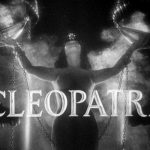Fetish Pop Culture turned up an interesting French book called La Papesse du Diable (The Devil’s female Pope) by Jehan Silvius and Pierre de Ruynes, 1931.

From a Google-translated summary:
Excellent example of the surreal eroticism of prewar, The High Priestess of the Devil (1931) appears to be due to the collaboration of Ernest Gengenbach and Robert Desnos. (Alexandrian.)
It attends to the entry into Paris of the Mistress of Asia, now Archimagesse Queen of the World, at the head of his hordes coming to conquer Europe. Theme dear to the surrealists, the high priestess of Satan is actually Isis, the wife, the mysterious, the archetypal.
Paris is upset, the streets be renamed; victory of evil forces absolute beneficial: the Great Androgyne throne at Notre Dame, the Pope prisoner is crucified on the Eiffel Tower. Everything ends with the end of the world and in a final orgy sacred General: A desire lascivious half opened the knees of women, men’s eyes gleamed. Everywhere tears, gasps, collapses paintings and cultural objects, cramp-like bristles. Dogs came from who knows where, covered the women gasped. An adolescent, arms outstretched, moaning slowly, half-stifled by four women. Three men in a corner hugged by meowing like girls entwined writhing on a couch …
So, is this an apocalyptic fantasy, the end of the world with a female Antichrist presiding over an orgy? Or is it a sexual fantasy with apocalyptic window-dressing? Is the sex sugar-coating the political/racial content, or vice versa? Books like this are a site for many discourses, and the surrealists had the eye for the end of the world, a key theme of the Gothic.
This is actually a little reminiscent of Bram Stoker’s Dracula, the modern, rationalist West invaded by the sexually deviant yet seductive East/Orient. The possibility of invasion/corruption is also the possibility of revolution and transformation.
Right now, our bookshelves and movie theatres and TV screens are crawling with the sexy undead, though often of a rather neutered strain. The dewey-eyed, sparkling-in-sunlight, heteronormative vampires of the Twilight franchise are a far cry from the polymorphously perverse, disturbing bloodsuckers of older literary incarnations. (By drawing explicit parallels between vampirism and homosexuality, True Blood at least injects a little queerness into the proceedings.)
Can a monster get worn out? Through excessive familiarity, does a monster loose its ability to frighten or inspire? Can you extract the sublimity from something? I’d like to raise Bram Stoker from the dead and sit him down in front of Twilight or The Vampire Diaries and ask him what he would think of the idea as vampires being heroes or romantic partners.
I think that on some weird, subconscious level, the threat of impurity, as represented by Dracula or The Devil’s Papess, also represents the possibility of change. Just as the classic “rape/ravishment” fantasy resolves the paradox of female desire vs. purity, the fantasy of the apocalypse resolves the need for revolution.



